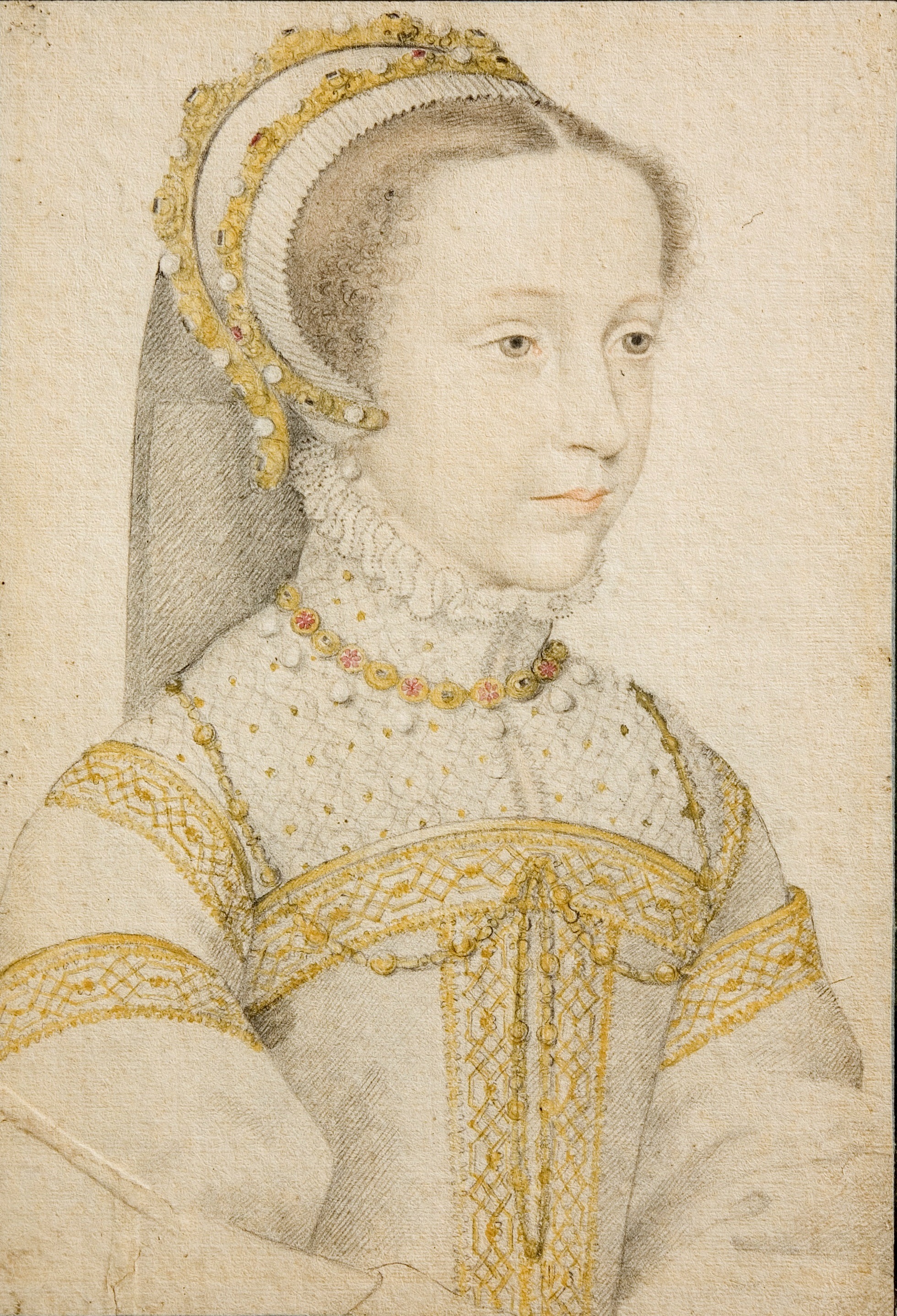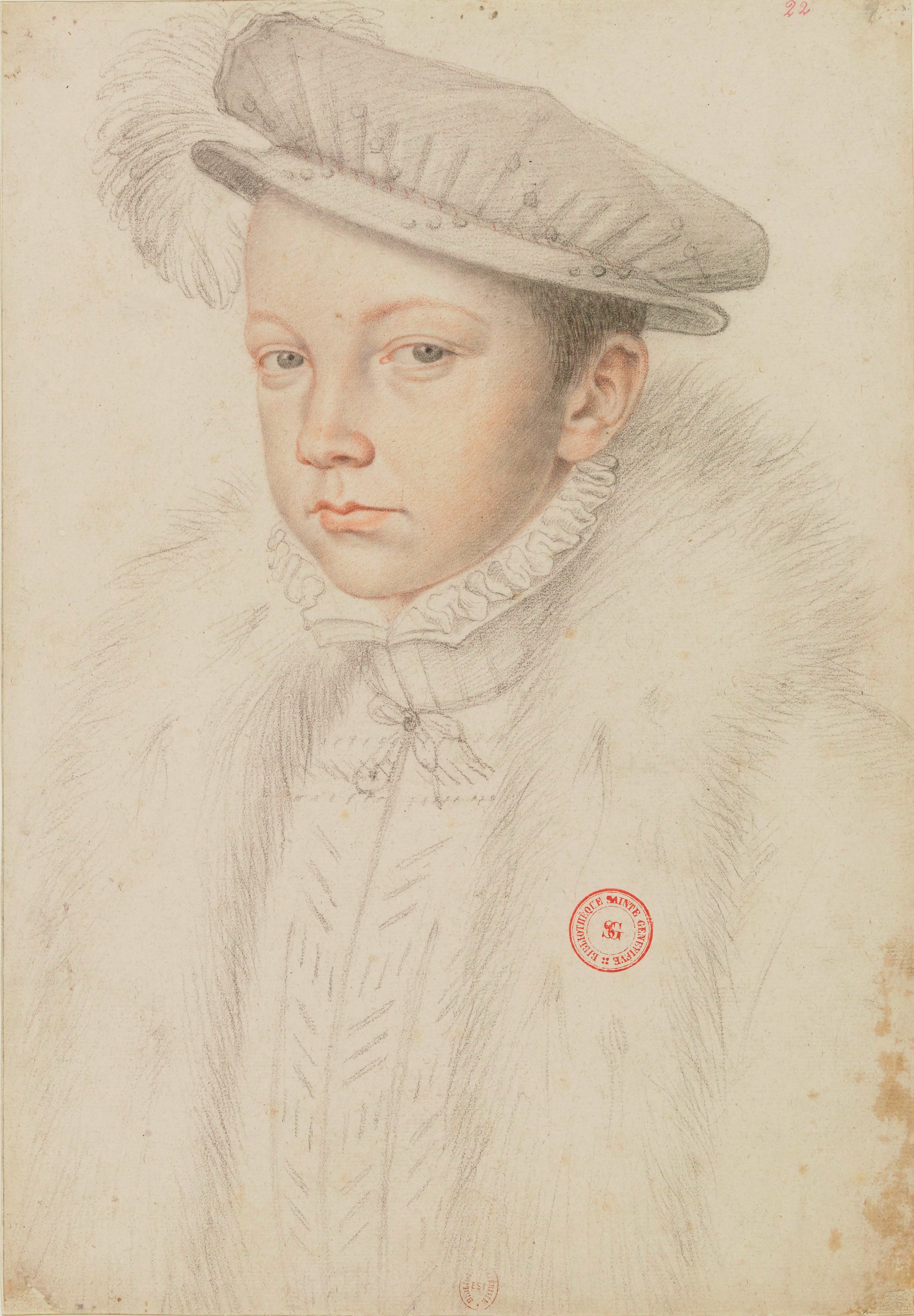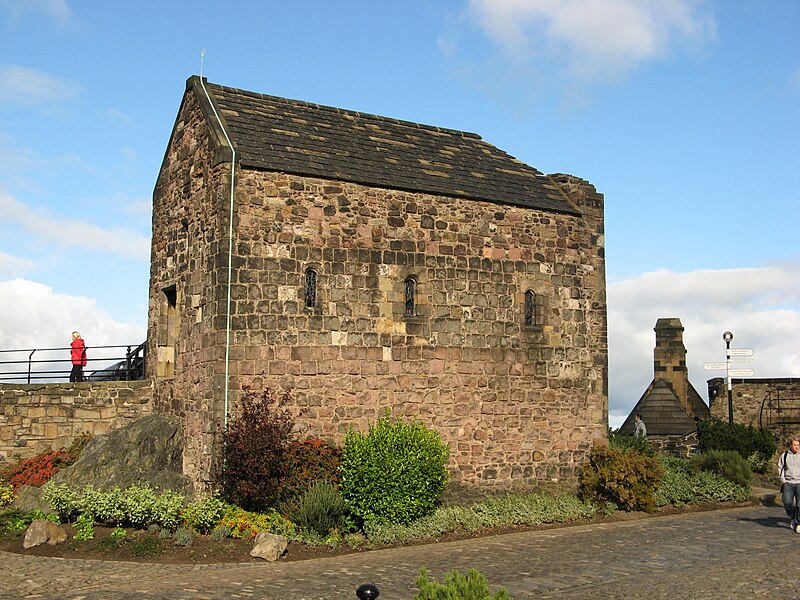by Susan Flantzer © Unofficial Royalty 2017

Marie of Guise, Queen of Scots; Credit – Wikipedia
Marie of Guise, the second wife of James V, King of Scots and the mother of Mary, Queen of Scots, was born November 22, 1515, in Bar-le-Duc, Duchy of Lorraine (now in France). She was the eldest of the twelve children of Claude of Lorraine, Duke of Guise, head of the House of Guise, and Antoinette de Bourbon, daughter of François de Bourbon, Count of Vendome.
Marie had eleven siblings:
- François, Duke of Guise (1519 – 1563), married Anna d’Este, had seven children
- Louise of Guise (1520 – 1542); married Charles I, Duke of Arschot, no issue
- Renée of Guise, Abbess of St. Pierre, Reims (1522 – 1602)
- Charles of Guise, Duke of Chevreuse, Archbishop of Reims, and Cardinal of Lorraine (1524 – 1574)
- Claude, Duke of Aumale (1526 – 1573), married Louise de Brézé, had eleven children
- Louis I, Cardinal of Guise (1527 – 1578)
- Philip of Guise (born and died 1529)
- Peter of Guise (born and died 1530)
- Antoinette of Guise, Abbess of Faremoutier (1531 – 1561)
- François of Guise, Grand Prior of the Order of Malta (1534 – 1563)
- René, Marquis of Elbeuf (1536 – 1566), married Louise de Rieux, had two children
Marie grew up with her large family at the family home, Château de Joinville. To complete her education, she was sent to the Poor Clares convent at Pont-à-Mousson, France where her paternal grandmother Philippa of Guelders, Duchess of Lorraine had become a nun. At the age of fourteen, Marie was a tall, beautiful, red-haired young woman. She so impressed her uncle and aunt Antoine, Duke of Lorraine and Renée of Bourbon, that they took her to their court to prepare her for life at the French court. In March 1531, Marie accompanied family members to the Basilica of St. Denis to attend the coronation of Eleanor of Austria, the second wife of King François I of France. Marie spent the next three years at the French court where she became close to Madeleine and Margaret, daughters of King François I of France. Ironically, Marie would succeed Madeleine as Queen of Scots after Madeleine died a month short of her seventeenth birthday, only six months after her marriage to James V, King of Scots.
On August 4, 1534, 18-year-old Marie married Louis II d’Orléans, Duke of Longueville at the Louvre Palace in Paris. The marriage was a happy one, but sadly, a short one. Louis died June 9, 1537, leaving Marie a 21-year-old pregnant widow. The couple had two children, but neither survived to adulthood:
- François III d’Orléans, Duke of Longueville (1535 – 1551), unmarried
- Louis d’Orléans (1537 – 1538)
On New Year’s Day in 1537, Marie and her husband attended the wedding of Princess Madeleine to James V, King of Scots at Notre Dame Cathedral in Paris. There Marie met for the first time the man who would become her second husband, James V, King of Scots. Marie’s husband died on June 9, 1537, and Madeleine died on July 7, 1537. Madeleine’s father, King François I of France, suggested that Marie marry his widowed son-in-law. However, Marie had another suitor, King Henry VIII of England, then the widower of Jane Seymour. When the French ambassador to England asked Henry VIII why he was eager to marry Marie, he said it was because she was big and he had a need for a big wife. When this was reported to Marie, she responded, “I may be big, but my neck is too small,” an obvious reference to the beheading of Henry’s second wife Anne Boleyn. Because of Henry VIII, the negotiations for Marie’s marriage to James V (who was Henry VIII’s nephew, the son of Henry’s sister Margaret) were hastened and James applied to the Pope for a dispensation since he and Marie were third cousins, both great-great-grandchildren of Arnold, Duke of Guelders. A proxy marriage took place in France on May 9, 1538, with Robert Maxwell, 5th Lord Maxwell, one of the ambassadors sent to the French court to negotiate the marriage, standing in for James V.

Engraving of the Proxy Marriage of Marie of Guise; Credit – Wikipedia
Marie sailed from Le Havre, France on June 10, 1538. She was forced to leave her three-year-old son François in France in the care of her mother Antoinette de Bourbon as he had succeeded his father as Duke of Longueville. On June 18, 1538, Marie and James V were married in person at St. Andrews Cathedral in St. Andrews, Fife, Scotland. Marie was crowned Queen of Scots at Holyrood Abbey in Edinburgh, Scotland on February 22, 1540.

James V and Marie of Guise; Credit – Wikipedia
Marie and James V had two sons and a daughter, but both sons died in early childhood:
- James, Duke of Rothesay (1540 – 1541)
- Robert, Duke of Albany (born and died 1541)
- Mary, Queen of Scots (1542 – 1587), married (1) King François II of France, no issue (2) Henry Stuart, Lord Darnley, had one son King James VI of Scotland/James I of England (3) James Hepburn, 4th Earl of Bothwell, no issue (miscarried twins)
When his mother Margaret Tudor, Queen of Scots died in 1541, James V saw no reason to keep the peace with England. When war broke out between England and France in 1542, it was inevitable that Scotland would go to war against England because of their treaty with France. When Henry VIII of England broke from the Roman Catholic Church, he asked his nephew James V, King of Scots, to do the same. James ignored his uncle’s request and further insulted him by refusing to meet him at York. Furious, Henry VIII sent troops against Scotland. In retaliation for the English raid into Scotland, James responded by assigning Robert Maxwell, Lord Maxwell, the Scottish Warden of West March, the task of raising an army. On November 24, 1542, the Battle of Solway Moss in Cumberland, England resulted in a decisive English victory.
After the Battle of Solway Moss, James V fled to Falkland Palace where he became ill and took to his bed. Overcome with grief and shame about the Battle of Solway Moss, James V lost the will to live. The news that Marie of Guise had given birth to a daughter on December 8, 1542, did nothing to raise his spirits. James V, King of Scots died at Falkland Palace in Fife, Scotland on December 14, 1542, at the age of 30. He was buried at Holyrood Abbey alongside his first wife Madeleine and his two sons by Marie of Guise. James’ tomb was desecrated in 1544 during the War of the Rough Wooing and his remains were reburied in the Royal Vault at Holyrood Abbey during the reign of Queen Victoria. James V was succeeded by his only surviving, legitimate child, six-day-old Mary, Queen of Scots.

Mary, Queen of Scots, about 12 years old; Credit – Wikipedia
James Hamilton, 2nd Earl of Arran, a great-grandson of James II, King of Scots and the heir to the Scots throne, became Regent of Scotland. The widowed Marie and her infant daughter Mary, Queen of Scots stayed at Linlithgow Castle until July 1543 when they moved to Stirling Castle. On September 9, 1543, Mary was crowned at Stirling Castle. After Mary’s coronation, Marie was appointed as the principal member of the Council of Regency. She was to assist and advise the Earl of Arran, whose power was greatly reduced.
Mary, Queen of Scot’s great-uncle King Henry VIII of England tried to force an agreement of marriage between Mary and his six-year-old son the future King Edward VI of England to create a new alliance between England and Scotland. Scotland had an alliance with France called the Auld Alliance. When Scotland resisted, Henry VIII declared war resulting in an eight-year war known as the Rough Wooing (1543 – 1581). Because of the English hostilities, Scotland abandoned the possibility of an English marriage. In July 1548, the Scottish Parliament approved Mary’s marriage to François, Dauphin of France, the son and heir of King Henri II of France. François became King of France and Mary became Queen of France in 1559 after King Henri II died after suffering a horrible injury in a tournament.

François, Dauphin of France, later King François II of France; Credit – Wikipedia
On August 7, 1548, five-year-old Mary, Queen of Scots set sail for France where she would be raised with her future husband, who she married in 1558. She would not return to Scotland for thirteen years. Mary’s mother Marie remained in Scotland as the principal member of the Council of Regency. Marie set out for a visit to France in September 1550. She spent a happy year in France reunited with her son François III d’Orléans, Duke of Longueville and her daughter Mary. Sadly, in 1551, her son François died shortly before Marie returned to Scotland.
Marie returned to Scotland via England where she was entertained by King Edward VI of England at Hampton Court Palace and the Palace of Westminster. Upon her return to Edinburgh, Scotland, Marie spent the next two years attempting to become the sole regent of Scotland. The Earl of Arran, a great-grandson of James II of Scotland, agreed to give up his position as regent on the condition that he would be next in line to the throne of Scotland after Mary, Queen of Scots if she died childless. However, the Scottish succession had been secretly promised to France. On April 12, 1554, the Earl resigned as regent and Marie was invested as Queen Regent.
Marie, as Queen Regent, was extremely capable and set out to bring justice, peace, and prosperity to her adopted country. However, she did have to contend with the beginnings of the Protestant Reformation. In 1559, John Knox, leader of the Scottish Reformation and the founder of the Presbyterian Church of Scotland, started his fiery sermons, encouraging people to destroy images and desecrate churches. Soon, the entire country was on the verge of a civil war and the former regent, the Earl of Arran, sided with the Protestants. The Protestants were receiving help from the Protestant Queen Elizabeth I of England who had succeeded to the English throne in 1558. The Catholic French gave aid to Marie so she could fortify Leith which was threatened to be besieged by the English.
When the English invaded Scotland in March 1560, Marie and her entourage moved to Edinburgh Castle which could be better fortified. While continuing to fortify Edinburgh Castle, Marie became seriously ill. Her mind began to wander and some days she could not even speak. She met with her last council on June 7, 1560. On June 11, 1560, 44-year-old Marie died of dropsy (edema).

St. Margaret’s Chapel, Edinburgh Castle; Photo Credit – By Jonathan Oldenbuck – Own work, CC BY-SA 3.0, https://commons.wikimedia.org/w/index.php?curid=5383510
Marie’s body was embalmed and placed in a lead coffin. It lay in St. Margaret’s Chapel at Edinburgh Castle until March 18, 1561. On that day, the coffin was secretly carried from the castle at midnight and taken to Leith where the coffin was placed on board a ship bound for France. Mary, Queen of Scots attended her mother’s funeral at Fécamp in July 1561. Marie of Guise was buried at the church in the Convent of Saint-Pierre in Reims where her sister Renée was abbess. A marble tomb was erected with a bronze statue of Marie in royal robes, holding a scepter and the rod of justice. The tomb was destroyed during the French Revolution.
This article is the intellectual property of Unofficial Royalty and is NOT TO BE COPIED, EDITED, OR POSTED IN ANY FORM ON ANOTHER WEBSITE under any circumstances. It is permissible to use a link that directs to Unofficial Royalty.
Works Cited:
- Ashley, M. and Lock, J. (2012). The mammoth book of British kings & queens. London: Constable & Robinson.
- De.wikipedia.org. (2017). Marie de Guise. [online] Available at: https://de.wikipedia.org/wiki/Marie_de_Guise [Accessed 19 Jul. 2017].
- En.wikipedia.org. (2017). Mary of Guise. [online] Available at: https://en.wikipedia.org/wiki/Mary_of_Guise [Accessed 19 Jul. 2017].
- Unofficial Royalty. (2017). James V, King of Scots. [online] Available at: https://www.unofficialroyalty.com/james-v-king-of-scots/ [Accessed 19 Jul. 2017].
- Unofficial Royalty. (2017). Mary, Queen of Scots. [online] Available at: https://www.unofficialroyalty.com/mary-queen-of-scots/ [Accessed 19 Jul. 2017].
- Williamson, D. (1996). Brewer’s British Royalty. London: Cassell.
